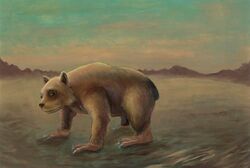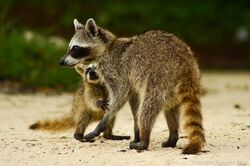Biology:Chapalmalania
| Chapalmalania | |
|---|---|

| |
| Scientific classification | |
| Domain: | Eukaryota |
| Kingdom: | Animalia |
| Phylum: | Chordata |
| Class: | Mammalia |
| Order: | Carnivora |
| Family: | Procyonidae |
| Genus: | †Chapalmalania Ameghino, 1908 |
| Species | |
| |
Chapalmalania is an extinct genus of procyonid from the Late Miocene or Early Pliocene to Early Pleistocene (Montehermosan to Uquian) of Argentina (Andalhualá Formation),[1] Venezuela (San Gregorio Formation, Venezuela),[2] and Colombia (Ware Formation, Cocinetas Basin, La Guajira).[3][4]
Description
Originally misidentified as a kind of bear, Chapalmalania is in fact a giant relative of raccoons and coatis, estimated to have weighed between 125 kilograms (276 lb) to 181 kilograms (399 lb), comparable in mass to small/medium sized ursids such as the American black bear (Ursus americanus) and spectacled bear (Tremarctos ornatus).[5]
Evolution
Such a drastic size increase compared to its North America cousins likely stems from a rapid evolutionary response upon arriving in South America, with Chapalmalania evolving from the "dog-coati" Cyonasua, which probably island-hopped from Central America during the late Miocene (7.5 million years ago), making them perhaps the earliest southward mammalian migrants of the Great American Interchange, and one of the few documented cases of trans-oceanic dispersals of carnivores mammals (the only other major examples being the Eupleridae of Madagascar and the Sulawesi palm civet of Sulawesi). It is thought the reason for this comes down to various aspects of procyonid biology that grant higher success at dispersing across ocean barriers than other carnivores. First, procyonids are excellent climbers, and can cling onto floating rafts of vegetation more effectively than more terrestrial carnivores. Secondly, their omnivorous diet allows them to take advantage of more food options when stranded out to sea, extending their survival and thus increasing their chances of making it to land. Finally, hypo carnivores like procyonids live at higher densities than mesocarnivores or hyper carnivores like mustelids, felids, and canids, thereby naturally increasing their chances at being swept out to sea in the first place due to greater abundance. Three other instances of trans-oceanic dispersal are documented among procyonids that further support these claims in practice, being the Cozumel Island Raccoon, Tres Marias Raccoon, and the Cozumel coati.[6]


It is thought that as the Isthmus of Panama rose from the sea to allow further invasions by other North American species, Chapalmalania was unable to compete and its lineage became extinct, especially with the arrival of Tremarctinae bears which appear to share similar dental morphologies with the large procyonid.[7] However, it is also possible the extinction of Chapalmalania was due to climatic changes that occurred during the Pleistocene that wiped out a number of the continent's native fauna (Such as the large terror birds like Titanis, megafaunal members of Dinomyidae, and various South American native ungulates), with bears filling in the empty niches upon their arrival to the continent during the Late Uquian.[8]
Paleoecology
Chapalmalania and Cyonasua are considered more carnivorous than other procyonids bar the modern-day Bassariscus, being classified as hypocarnivores. It is thought that Chapalmalania would have had an omnivorous diet similar to modern bears based on dental morphology, plotting especially close to the modern day Spectacled Bear.[9][10] Being omnivorous would have allowed them to niche-partition with the hypercarnivorous sparassodonts and terror birds that it lived alongside. Bite marks attributable to Chapalmalania have been found on a glyptodont carcass and have been interpreted as scavenging behavior, suggesting that Chapalmalania also fed on carrion of large mammals such as glyptodonts on at least some occasions, the blunt cusps of its molars well designed to grind down tough foods.[11]
References
- ↑ Reguero, M; Candela, A (April 2011). "Late Cenozoic mammals from the Northwest of Argentina". Cenozoic Geology of the Central Andes of Argentina: 411–426. https://www.researchgate.net/publication/241687286. Retrieved September 28, 2023.
- ↑ Carrillo-Briceño, Jorge D.; Sánchez, Rodolfo; Scheyer, Torsten M.; Carrillo, Juan D.; Delfino, Massimo; Georgalis, Georgios L.; Kerber, Leonardo; Ruiz-Ramoni, Damián et al. (2021). "A Pliocene–Pleistocene continental biota from Venezuela". Swiss Journal of Palaeontology 140 (9): 9. doi:10.1186/s13358-020-00216-6. PMID 34721281.
- ↑ Forasiepi, Analia M.; Soibelzon, Leopoldo H.; Gomez, Catalina Suarez; Sánchez, Rodolfo; Quiroz, Luis I.; Jaramillo, Carlos; Sánchez-Villagra, Marcelo R. (17 September 2014). "Carnivorans at the Great American Biotic Interchange: new discoveries from the northern neotropics". Naturwissenschaften 101 (11): 965–974. doi:10.1007/s00114-014-1237-4. PMID 25228347. https://www.zora.uzh.ch/id/eprint/100686/8/ZORA_NL_100686.pdf.
- ↑ Chapalmalania at Fossilworks.org
- ↑ Forasiepi, Analía M.; Prevosti, Francisco J. (2018). Evolution of South American mammalian predators during the Cenozoic : paleobiogeographic and paleoenvironmental contingencies. Cham: Springer. pp. 124–125. ISBN 978-3-319-03701-1.
- ↑ Engelman, Russell K.; Croft, Darin A. (12 September 2019). "Strangers in a strange land: Ecological dissimilarity to metatherian carnivores may partly explain early colonization of South America by Cyonasua-group procyonids". Paleobiology 45 (4): 598–611. doi:10.1017/pab.2019.29.
- ↑ Palmer, D., ed (1999). The Marshall Illustrated Encyclopedia of Dinosaurs and Prehistoric Animals. London: Marshall Editions. p. 215. ISBN 1-84028-152-9.
- ↑ Carrillo, J; Faurbey, S (5 October 2020). "Disproportionate extinction of South American mammals drove the asymmetry of the Great American Biotic Interchange". PNAS 117 (42): 26281–26287. doi:10.1073/pnas.2009397117.
- ↑ Engelman, Russell K.; Croft, Darin A. (12 September 2019). "Strangers in a strange land: Ecological dissimilarity to metatherian carnivores may partly explain early colonization of South America by Cyonasua-group procyonids". Paleobiology 45 (4): 598–611. doi:10.1017/pab.2019.29.
- ↑ Kraglievich, J.L.; de Olazabal, A.G.. "Los prociónidos extinguidos del género Chapalmalania Amegh.". Revista del Museo Argentino de Ciencias Naturales, Ciencias Zoologícas 6: 1–59.
- ↑ de los Reyes, Martín; Poiré, Daniel; Soibelzon, Leopoldo; Zurita, Alfredo E.; Arrouy, M.J. (2013). "First evidence of scavenging of a Glyptodont (Mammalia, Glyptodontidae) from the Pliocene of the Pampean region (Argentina): taphonomic and paleoecological remarks". Palaeontologia Electronica 16 (2;15A): 1–13. doi:10.26879/331. https://palaeo-electronica.org/content/2013/434-scavenging-of-a-glyptodont.
Further reading
- Barry Cox, Colin Harrison, R.J.G. Savage, and Brian Gardiner. (1999): The Simon & Schuster Encyclopedia of Dinosaurs and Prehistoric Creatures: A Visual Who's Who of Prehistoric Life. Simon & Schuster.
- David Norman. (2001): The Big Book Of Dinosaurs. page 13, Walcome books.
External links
Wikidata ☰ Q2566925 entry
 |

